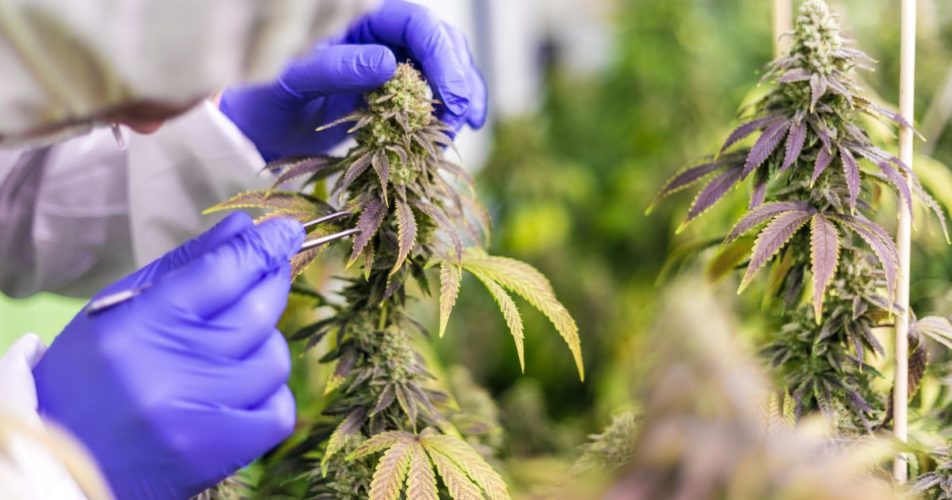Where did cannabis come from? It’s a question that sparks curiosity and intrigue.
This mysterious plant has had a long-standing relationship with humankind for many centuries, yet its source remains somewhat enigmatic.
By tracing cannabis’ evolutionary journey, we’ll gain insight into its genetic lineage, historical uses and modern advancements in THC & CBD production.
In this post, we’ll embark on an evolutionary journey tracing back where did cannabis come from, exploring its genetic lineage, historical uses, and modern advancements in THC & CBD production. Buckle up!
Table of Contents:
- Genetic Origin of Cannabis
- Evolutionary Role of Cannabinoids in Cannabis
- Early Human Use and Domestication
- Artificial Selection Impact on Cannabis Characteristics
- Modern Advancements In Producing THC And CBD
- FAQs in Relation to Where Did Cannabis Come From
- Conclusion
- Where did cannabis come from?
Genetic Origin of Cannabis
The genetic history of cannabis is a fascinating journey that takes us back millions of years.
Astonishingly, it’s believed that the plant we know today as cannabis and its botanical cousin hops diverged approximately 28 million years ago. Scientific studies have traced this divergence through molecular dating techniques.
Divergence from Hops
Cannabis and hops share a common ancestor but took different evolutionary paths over time.
Hops continued to evolve into the beer flavoring agent we’re familiar with today, while our beloved marijuana pursued an entirely unique path. The two plants still bear some similarities – they both belong to the Cannabaceae family after all – yet their uses couldn’t be more distinct due to their differing chemical compositions.
Emergence of Cannabinoids
Marijuana‘s psychotropic effects are mainly caused by cannabinoids, which are exclusive substances in the herb.
This wasn’t always so – these chemicals only appeared in cannabis following its split from hops.
The emergence of cannabinoids might seem random at first glance; however, there could be intriguing reasons behind it tied closely with survival strategies against environmental threats such as UV radiation or predation by herbivores.
In essence, what started out as simple burned cannabis seeds evolved into complex structures capable of producing intoxicating substances like THC (marijuana’s primary psychoactive compound).

Intriguing isn’t it? Now let’s dive deeper into how exactly these protective measures may have developed over time.
Evolutionary Role of Cannabinoids in Cannabis
The emergence of cannabinoids, the primary cause of marijuana’s psychoactive effects, is an intriguing subject to investigate; some scientists believe it could be a response to environmental threats like UV radiation or predation.
Scientists have theorized that the emergence of cannabinoids may be an evolutionary adaptation to environmental pressures such as UV radiation and predation by herbivores.
Protection Against UV Light
Cannabis plants are often exposed to harsh sunlight during their growth period. This can lead them vulnerable to damage from harmful ultraviolet (UV) rays, helping the plant survive and thrive under intense solar conditions.
Defense Mechanism Against Herbivores
In addition, it has been suggested that cannabis developed its unique blend of cannabinoids as part of a defense mechanism against being eaten by animals.
Burning cannabis seeds produce smoke which deters many types of insects and other small creatures from approaching the plant, a clear example where smoldering cannabis seeds played an important role in protecting itself.
Marijuana’s side effects both mental and physical might also serve another purpose – they could deter larger herbivores from consuming too much due to unpleasant reactions after ingestion.
If you’ve ever wondered why smoking marijuana leads so often towards feelings relaxation euphoria then consider how those same sensations would affect an animal intent on munching down an entire crop.
Average THC Content Over Time: The Evolution Continues?
We should note though that over time, the drug’s potency has increased dramatically, especially when comparing average THC content present-day strains versus ones available just a few decades ago.
According to a study published in the Biological Psychiatry Journal, this rise isn’t necessarily because of changes in the natural environment but rather a result of human intervention through selective breeding practices aimed at boosting levels of the psychoactive compound within each bud, resulting in higher yielding and more potent varieties enjoyed by users around the world today.
Key Takeaway:
Cannabinoids in cannabis may have evolved as a defense mechanism against UV radiation and herbivores. The psychoactive effects of marijuana could deter larger herbivores from consuming too much. Selective breeding by humans has led to an increase in THC content over time.
Early Human Use and Domestication
The history of cannabis use is as diverse as the plant itself.
Mankind’s relationship with marijuana dates back thousands of years across various cultures, serving both medicinal and industrial purposes.
Medicinal Uses Across Cultures
Ancient societies recognized marijuana’s medicinal properties early on.
In China, for instance, burned cannabis seeds were used in traditional medicine to manage pain and other ailments.
This practice was not exclusive to Asia; Romans also leveraged these therapeutic benefits while smoking marijuana during their rituals.
Industrial Applications in History
Beyond its health applications, humans discovered that they could grow hemp – a variety of Cannabis sativa – for practical uses too.
Hemp fields became common sights across Europe where this versatile crop served multiple roles from making ropes to clothes due its strong fibres.
Greeks utilized it extensively in shipbuilding whereas Indians made durable textiles out of it.
As we delve further into history, we find evidence suggesting that even American colonists grew hemp plants widely before the advent of cotton gins.
In essence, the story behind human interaction with cannabis isn’t just about intoxicating substances or seeking relief through natural remedies.
It’s equally about harnessing nature’s gifts towards building civilizations by creating everyday items like clothing materials or sailing equipment.
This rich past sets up an intriguing stage for understanding how artificial selection has shaped modern strains over time.
So let us now explore what impact selective breeding had on differentiating between psychoactive varieties and industrially-focused ones such as Hemp.
Artificial Selection Impact on Cannabis Characteristics
The journey of cannabis through history has been shaped significantly by artificial selection.
This process, driven by human intervention, has led to notable changes in the characteristics of different strains over time.
Distinction Between Hemp & Psychoactive Varieties
Hemp and psychoactive marijuana are two distinct varieties that have emerged as a result of selective breeding practices.
A key difference lies in their physical attributes and chemical compositions.
Hemp, for instance, is typically taller with more fibers but less THC content compared to its psychoactive counterparts.
Marijuana’s psychotropic effects are attributed to its higher THC levels, as opposed to hemp.
This distinction was primarily due to growers selecting specific traits beneficial for their purposes – whether it be industrial use or intoxicating substances.
Impact Of Selective Breeding On THC Levels
Selective breeding also played a crucial role in manipulating the average THC content within various cannabis strains.
Breeding plants with high-THC concentrations resulted in strains ideal for smoking marijuana, thus enhancing marijuana’s medicinal properties while increasing drug potency dramatically.
Gone were the days when our ancestors burned cannabis seeds – today we’re dealing with highly potent buds thanks largely to these cultivation techniques.
Despite this progress though, marijuana medical marijuana still faces legal challenges across many parts globally, making research into further potential benefits somewhat restricted.
Moving forward however, understanding how humans influenced genetic diversity among cannabis will continue being critical not only for those who grow hemp, but also researchers studying both mental side-effects and therapeutic potentials associated with cannabinoids like CBD and THC.
Modern Advancements In Producing THC And CBD
The cannabis cultivation and production industry has been significantly transformed by the latest technological developments.
In an era where the average THC content is a major concern for both growers and users, scientists have found innovative ways to produce these intoxicating substances without even needing a cannabis plant.
GMO Production Of Cannabinoids
A ground-breaking method that’s gaining traction involves genetically engineering bacteria within yeast to produce cannabinoids such as THC (marijuana’s mind-altering effects) and CBD (known for marijuana’s medicinal properties).
This process mimics how nature creates these compounds but does so in controlled laboratory conditions.
Beyond just being fascinating science, this development could potentially solve several challenges faced by traditional methods of growing hemp or smoking marijuana.
For instance, it eliminates concerns about crop failure due to pests or adverse weather conditions which can be detrimental when trying to grow hemp fields industrially.
This GMO approach also allows us control over the drug’s potency which has increased dramatically with conventional breeding techniques used on burned cannabis seeds from smoldering cannabis seed piles – ensuring safer consumption experiences especially important given marijuana medical marijuana use cases.
Furthermore, it offers potential solutions around legal restrictions associated with cultivating psychoactive strains since technically no actual “weed” is grown. This might not specifically prohibit cannabis under current laws like those enacted during the Marijuana Tax Act designed initially intended criminalize marijuana nationwide.
To say we’ve come far would be an understatement considering our ancestors’ prohibition era view towards pot – indeed today Philippines are becoming a major source of imported hemp fiber fell into disuse thanks largely part Drug Abuse Resistance Education programs aimed at preventing misuse among youth populations.
Key Takeaway:
Modern advancements in technology have revolutionized cannabis cultivation and production. Scientists are now genetically engineering bacteria within yeast to produce THC and CBD, eliminating concerns about crop failure and allowing for control over potency. This method also offers potential solutions to legal restrictions on psychoactive strains.
FAQs
Where did Cannabis come from originally?
Cannabis is believed to have originated in Central Asia, possibly in the regions that are now Mongolia and southern Siberia.
What Is the History of Cannabis?
The use of cannabis dates back thousands of years across various cultures for medicinal, spiritual, and industrial purposes. It has been selectively bred over time leading to distinct characteristics seen today.
Conclusion
So, we’ve journeyed back millions of years to the genetic origin of cannabis.
We’ve seen how it diverged from hops and developed unique cannabinoids as a survival strategy against UV radiation and herbivores.
The long history of human interaction with this plant was explored, revealing its early medicinal and industrial uses across various cultures.
Then came the era of artificial selection where humans shaped cannabis into hemp for industrial use or psychoactive strains for recreational purposes.
In recent times, science has even found ways to produce THC & CBD without needing the plant itself!
Where did cannabis come from?
A humble beginning in nature’s lap to being an integral part of human civilization – that’s quite a journey! And there’s so much more you can learn about this fascinating plant.
If you’re intrigued by what you’ve read here today and want to delve deeper into all things weed-related – perhaps even learning how to grow your own – then GreenBudGuru.com is just right for you!
Come join us at GreenBudGuru; let’s continue exploring together the captivating world of Cannabis cultivation. Your green thumb awaits!
Originally posted 2023-07-22 14:37:01.


 James Alexander
James Alexander